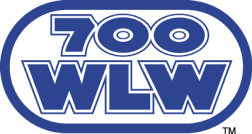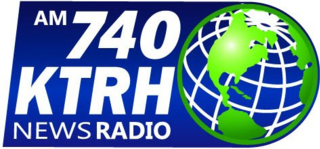Related Research Articles
WTVN – branded as "News Radio 610 WTVN" – is a commercial news/talk radio station licensed to Columbus, Ohio. Owned by iHeartMedia, the station serves the Columbus metro area. The WTVN studios area located in the McKinley Avenue Corridor northwest of Downtown Columbus, and its transmitter site is near Obetz. In addition to a standard analog transmission, the station simulcasts over the HD digital subchannel of co-owned 93.3 WODC, and streams online via iHeartRadio. WTVN began broadcasting in HD Radio in June 2005, but the in-band on-channel subcarrier was discontinued by 2015.

WLW is a commercial news/talk radio station licensed to Cincinnati, Ohio. Owned by iHeartMedia, WLW is a clear-channel station, often identifying itself as “The Big One”. Its studios are located in Sycamore Township.

WBBR is a Class A clear-channel radio station licensed to New York City. It serves as the flagship station of Bloomberg Radio, Bloomberg L.P.'s radio service. The station offers general and financial news reports 24-hours a day, along with local information and interviews with corporate executives, economists, and industry analysts.
KXLY is a commercial AM radio station in Spokane, Washington. It broadcasts a news/talk radio format with the branding "920 News Now". The station is owned by QueenB Radio, with its license held by Morgan Murphy Media.

WADO is a commercial radio station licensed to New York City. It is owned by Latino Media Network. It broadcasts a Spanish-language sports radio format.
WCRW was an AM radio station in Chicago, Illinois, which operated on a "shared time" frequency until 1996 with two other stations, WEDC and WSBC, each broadcasting a part of the day.
KFQD is a commercial radio station in Anchorage, Alaska branded as "News Talk 750 and 103.7 KFQD". It broadcasts a news/talk format and is owned by Alpha Media LLC. The studios and offices are on Arctic Slope Avenue in Anchorage.

KTRH is a commercial radio station licensed to Houston, Texas. It airs a news/talk radio format and is owned by iHeartMedia, Inc. Its studios are along the West Loop Freeway (I-610) in the city's Uptown district. The transmitter site, a four-tower array, is in unincorporated Liberty County, off Cox Road in Dayton. KTRH is one of the oldest radio stations in the United States, first licensed to Austin on April 22, 1922. Programming is also heard on co-owned KODA's HD 2 subchannel at 99.1MHz, and on the iHeartRadio platform. KTRH is Southeast Texas' primary entry point station for the Emergency Alert System.

WSAR is a commercial radio station licensed to Fall River, Massachusetts. Its studios and transmitter site are located in Somerset, Massachusetts. Its transmitter power output is 5,000 watts unlimited hours, using two towers in a fulltime directional pattern.
WHAZ is a commercial AM radio station licensed to Troy, New York, and serving New York's Capital District. The station is locally owned by the Capital Media Corporation and broadcasts a Christian talk and teaching radio format. National religious leaders heard on WHAZ include Jim Daly, Charles Stanley, Joyce Meyer, Chuck Swindoll and David Jeremiah.

WHP is a commercial AM radio station licensed to Harrisburg, Pennsylvania, serving the Harrisburg metropolitan area of South Central Pennsylvania. It broadcasts a talk radio format and is owned by iHeartMedia, Inc. The studios are on Corporate Circle in Harrisburg, off North Progress Avenue.
WYCK is a radio station that is owned by Bold Gold Media. Licensed to the city of Plains, it serves the Wilkes-Barre/Scranton radio market and broadcasts with 810 watts, non-directional.
WFBG is a radio station broadcasting an adult top 40/CHR radio format in Altoona, Pennsylvania. It transmits with 5,000 watts during the day, and 1,000 watts at night. WFBG's programming is also heard on 92.1 WJHT in Johnstown.
KMJ is a commercial AM radio station in Fresno, California. It airs a news/talk radio format, and simulcasts with sister station KMJ-FM. Owned by Cumulus Media, the studios and offices are located at the Radio City building on Shaw Avenue in North Fresno.
KPQ is a commercial AM radio station, licensed to Wenatchee, Washington, and serving the North Central Washington region. The station is owned by Townsquare Media and broadcasts a news/talk radio format. The radio studios and offices are on North Wenatchee Avenue.

WLAP is a commercial AM radio station in Lexington, Kentucky, serving the Central Kentucky region. It airs a news/talk format and is owned by iHeartMedia, Inc. The studios and offices are on Nicolasville Road in Lexington.

WSOY is a commercial AM radio station broadcasting a Talk radio format. Licensed to Decatur, Illinois, the station is owned by Neuhoff Corp., through licensee Neuhoff Media Decatur, LLC. Neuhoff owns four other local radio stations, WCZQ, WDZ, WDZQ and WSOY-FM. Studios and offices are located on North Water Street and the transmitter site is near St. Louis Bridge Road, sharing the same tower as WDZ.
WFLA was an AM radio station in Boca Raton, Florida, owned in 1927 by the Boca Raton Radio Corporation and funded by the Mizner Development Corporation. It was created to promote a land development project headed by Addison Mizner, and was intended be heard in "most of the eastern United States".
WJAZ was the call sign used from 1922 to 1931 by a series of four separate, but closely related, broadcasting stations located in Chicago, Illinois and operated by the Chicago Radio Laboratory/Zenith Radio Corporations.
WCHI was a radio station in Chicago, Illinois, United States, that operated from January 1, 1925, until it was deleted in 1932. The station—owned by the Peoples Pulpit Association, a corporation of the Jehovah's Witnesses—was established as WORD in Batavia before moving to Chicago in 1930 and changing its call letters. At the time of its deletion, it was transmitting with 5,000 watts on 1490 kHz. Its license was revoked by the Federal Radio Commission (FRC) over its attacks on the medical profession and in order to allow another station full-time use of the 1490 kHz frequency.
References
- 1 2 3 4 "Seek WLWL channel for western college" . The New York Times. September 26, 1929. p. 24. Retrieved April 1, 2022.
- 1 2 "Thomas Dongan Council assists radio station". The Tablet. New York, Brooklyn. December 23, 1933. p. 7. Retrieved April 1, 2022– via Newspapers.com.
- 1 2 "Memorandum for Judge Sykes" by George B. Porter, January 22, 1935, pages 61-62.
- ↑ "New Stations", Radio Service Bulletin, September 1, 1925, page 3.
- ↑ "What's in a Station Call?" by Madeleine Moshenross, All-Wave, September 1936, page 375.
- ↑ "Radio Conference Recommendations: New Wavelengths", Radio Age, May 1923, page 11.
- ↑ "News of All Radio Happenings". Times Union. New York, Brooklyn. September 25, 1925. p. 15. Retrieved April 1, 2022– via Newspapers.com.
- ↑ "WLWL Equipped With Finest Broadcasting Instruments". The Brooklyn Citizen. New York, Brooklyn. September 27, 1925. p. 15. Retrieved April 1, 2022– via Newspapers.com.
- ↑ "Premier Quartet Oldest on the Air". Yonkers Statesman. August 14, 1926. p. 8. Retrieved April 1, 2022– via Newspapers.com.
- ↑ "Alterations and corrections", Radio Service Bulletin, December 1, 1925, page 7.
- ↑ "Alterations and corrections", Radio Service Bulletin, February 27, 1926, page 7.
- ↑ "Federal Regulation of Radio Broadcasting" (July 8, 1926) by Acting Attorney General William J. Donovan, Official Opinions of the Attorneys General of the United States, Volume 35, 1929, pages 126-132.
- ↑ "WLWL cuts WOR, H. V. K.'s listeners complain to Eagle". The Brooklyn Daily Eagle. November 7, 1926. p. 16 B. Retrieved April 1, 2022– via Newspapers.com.
- ↑ "Broadcasting stations, alphabetically by call signals" (as of December 31, 1926), Radio Service Bulletin, December 31, 1926, page 19.
- ↑ "Broadcasting Stations by Wave Lengths", Radio Service Bulletin, May 31, 1927, page 11.
- ↑ "Two ask new allocation" . The New York Times. June 9, 1927. p. 22. Retrieved April 1, 2022.
- ↑ "Alterations and corrections", Radio Service Bulletin, June 30, 1927, page 10.
- ↑ "Alterations and corrections", Radio Service Bulletin, January 31, 1928, page 5.
- ↑ "WLWL gets leave to use full power" . The New York Times. December 5, 1927. p. 29. Retrieved April 1, 2022.
- ↑ "Revised list of broadcasting stations, by frequencies, effective 3 a. m., November 11, 1928, eastern standard time", Second Annual Report of the Federal Radio Commission for the Year Ended June 30, 1928, Together With Supplemental Report for the Period From July 1, 1928 to September 30, 1928, page 205.
- 1 2 "Paulists seek radio aid". The New York Times. November 11, 1929. p. 23. Retrieved April 1, 2022.
- ↑ "Hearst Negotiating To Acquire WLWL", Broadcasting, November 15, 1931, page 16.
- ↑ "Examiner's Reports . . .: WLWL, New York, and WPG, Atlantic City", Broadcasting, November 1, 1931, page 29.
- ↑ "Labor Group Asks New York Station", Broadcasting, September 1, 1932, page 10.
- ↑ "Move of WLWL for Full-Time Is Upset; Transfer of WOV to Bulova Approved", Broadcasting, November 1, 1936, page 24.
- ↑ "Bulova Advances Plan For Network", Broadcasting, May 15, 1937, page 81.
- ↑ "WBIL Planned as Key Station of Bulova Net", Broadcasting, July 1, 1937, page 18.
- ↑ "Bulova Gets New York Facility But May Face Long Litigation", Broadcasting, July 15, 1939, page 32.